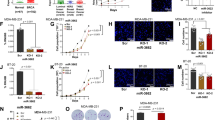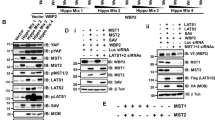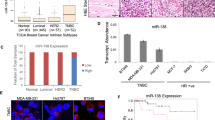Abstract
The transcription factor FOXP3 has been identified as a tumour suppressor in the breast and prostate epithelia, but little is known about its specific mechanism of action. We have identified a feed-forward regulatory loop in which FOXP3 suppresses the expression of the oncogene SATB1. In particular, we demonstrate that SATB1 is not only a direct target of FOXP3 repression, but that FOXP3 also induces two miRs, miR-7 and miR-155, which specifically target the 3′-UTR of SATB1 to further regulate its expression. We conclude that FOXP3-regulated miRs form part of the mechanism by which FOXP3 prevents the transformation of the healthy breast epithelium to a cancerous phenotype. Approaches aimed at restoring FOXP3 function and the miRs it regulates could help provide new approaches to target breast cancer.
This is a preview of subscription content, access via your institution
Access options
Subscribe to this journal
Receive 50 print issues and online access
$259.00 per year
only $5.18 per issue
Buy this article
- Purchase on Springer Link
- Instant access to full article PDF
Prices may be subject to local taxes which are calculated during checkout








Similar content being viewed by others
References
Barry SC, Harder B, Brzezinski M, Flint LY, Seppen J, Osborne WR . (2001). Lentivirus vectors encoding both central polypurine tract and posttranscriptional regulatory element provide enhanced transduction and transgene expression. Hum Gene Ther 12: 1103–1108.
Bartel DP . (2009). MicroRNAs: target recognition and regulatory functions. Cell 136: 215–233.
Blenkiron C, Goldstein LD, Thorne NP, Spiteri I, Chin SF, Dunning MJ et al. (2007). MicroRNA expression profiling of human breast cancer identifies new markers of tumor subtype. Genome Biol 8: R214.
Bommer GT, Gerin I, Feng Y, Kaczorowski AJ, Kuick R, Love RE et al. (2007). p53-mediated activation of miRNA34 candidate tumor-suppressor genes. Curr Biol 17: 1298–1307.
Brosh R, Shalgi R, Liran A, Landan G, Korotayev K, Nguyen GH et al. (2008). p53-repressed miRNAs are involved with E2F in a feed-forward loop promoting proliferation. Mol Syst Biol 4: 229.
Brown CY, Sadlon T, Gargett T, Melville E, Zhang R, Drabsch Y et al. (2010). Robust, reversible gene knockdown using a single lentiviral short hairpin RNA vector. Hum Gene Ther 21: 1005–1017.
Cai S, Han HJ, Kohwi-Shigematsu T . (2003). Tissue-specific nuclear architecture and gene expression regulated by SATB1. Nat Genet 34: 42–51.
Chen GY, Chen C, Wang L, Chang X, Zheng P, Liu Y . (2008). Cutting edge: broad expression of the FoxP3 locus in epithelial cells: a caution against early interpretation of fatal inflammatory diseases following in vivo depletion of FoxP3-expressing cells. J Immunol 180: 5163–5166.
Cheng C, Fu X, Alves P, Gerstein M . (2009). mRNA expression profiles show differential regulatory effects of microRNAs between estrogen receptor-positive and estrogen receptor-negative breast cancer. Genome Biol 10: R90.
Cheng C, Lu X, Wang G, Zheng L, Shu X, Zhu S et al. (2010). Expression of SATB1 and heparanase in gastric cancer and its relationship to clinicopathologic features. APMIS 118: 855–863.
Farazi TA, Spitzer JI, Morozov P, Tuschl T . (2010). miRNAs in human cancer. J Pathol 223: 102–115.
Feuerer M, Hill JA, Mathis D, Benoist C . (2009). Foxp3+ regulatory T cells: differentiation, specification, subphenotypes. Nat Immunol 10: 689–695.
Filipowicz W, Bhattacharyya SN, Sonenberg N . (2008). Mechanisms of post-transcriptional regulation by microRNAs: are the answers in sight? Nat Rev Genet 9: 102–114.
Foekens JA, Sieuwerts AM, Smid M, Look MP, de Weerd V, Boersma AW et al. (2008). Four miRNAs associated with aggressiveness of lymph node-negative, estrogen receptor-positive human breast cancer. Proc Natl Acad Sci USA 105: 13021–13026.
Fontenot JD, Gavin MA, Rudensky AY . (2003). Foxp3 programs the development and function of CD4+CD25+ regulatory T cells. Nat Immunol 4: 330–336.
Galande S, Purbey PK, Notani D, Kumar PP . (2007). The third dimension of gene regulation: organization of dynamic chromatin loopscape by SATB1. Curr Opin Genet Dev 17: 408–414.
Gavin MA, Rasmussen JP, Fontenot JD, Vasta V, Manganiello VC, Beavo JA et al. (2007). Foxp3-dependent programme of regulatory T-cell differentiation. Nature 445: 771–775.
Han H-J, Rudsso J, Kohwi Y, Kohwi-Shigematsu T . (2008). SATB1 reprogrammes gene expression to promote breast tumour growth and metastasis. Nature 452: 187–193.
Hanker LC, Karn T, Mavrova-Risteska L, Ruckhaberle E, Gaetje R, Holtrich U et al. (2010). SATB1 gene expression and breast cancer prognosis. Breast (e-pub ahead of print; dx.doi.org/10.1016/j.breast.2010.10.002).
Hill JA, Feuerer M, Tash K, Haxhinasto S, Perez J, Melamed R et al. (2007). Foxp3 transcription-factor-dependent and -independent regulation of the regulatory T cell transcriptional signature. Immunity 27: 786–800.
Iorio MV, Ferracin M, Liu C, Veronese A, Spizzo R, Sabbioni S et al. (2005). MicroRNA gene expression deregulation in human breast cancer. Cancer Res 65: 7065–7070.
Iorns E, Hnatyszyn HJ, Seo P, Clarke J, Ward T, Lippman M . (2010). The role of SATB1 in breast cancer pathogenesis. J Natl Cancer Inst 102: 1284–1296.
Josefowicz SZ, Rudensky A . (2009). Control of regulatory T cell lineage commitment and maintenance. Immunity 30: 616–625.
Jung DJ, Jin DH, Hong SW, Kim JE, Shin JS, Kim D et al. (2010). Foxp3 expression in p53-dependent DNA damage responses. J Biol Chem 285: 7995–8002.
Kefas B, Godlewski J, Comeau L, Li Y, Abounader R, Hawkinson M et al. (2008). microRNA-7 inhibits the epidermal growth factor receptor and the Akt pathway and is downregulated in glioblastoma. Cancer Res 68: 3566–3572.
Kohlhaas S, Garden OA, Scudamore C, Turner M, Okkenhaug K, Vigorito E . (2009). Cutting edge: the Foxp3 target miR-155 contributes to the development of regulatory T cells. J Immunol 182: 2578–2582.
Kohwi-Shigematsu T, Han HJ, Russo J, Kohwi Y . (2010). Re: The role of SATB1 in breast cancer pathogenesis. J Natl Cancer Inst 102: 1879–1880.
Kong W, He L, Coppola M, Guo J, Esposito NN, Coppola D et al. (2010). MicroRNA-155 regulates cell survival, growth, and chemosensitivity by targeting FOXO3a in breast cancer. J Biol Chem 285: 17869–17879.
Ladoire S, Arnould L, Mignot G, Coudert B, Rebe C, Chalmin F et al. (2011). Presence of Foxp3 expression in tumor cells predicts better survival in HER2-overexpressing breast cancer patients treated with neoadjuvant chemotherapy. Breast Cancer Res Treat 125: 65–72.
Li QQ, Chen ZQ, Cao XX, Xu JD, Xu JW, Chen YY et al. (2010a). Involvement of NF-kappaB/miR-448 regulatory feedback loop in chemotherapy-induced epithelial–mesenchymal transition of breast cancer cells. Cell Death Differ 18: 16–25.
Li QQ, Chen ZQ, Xu JD, Cao XX, Chen Q, Liu XP et al. (2010b). Overexpression and involvement of special AT-rich sequence binding protein 1 in multidrug resistance in human breast carcinoma cells. Cancer Sci 101: 80–86.
Liu R, Wang L, Chen G, Katoh H, Chen C, Liu Y et al. (2009). FOXP3 upregulates p21 expression by site-specific inhibition of histone deacetylase 2/histone deacetylase 4 association to the locus. Cancer Res 69: 2252–2259.
Liu Y, Wang L, Zheng P . (2010). X-linked tumor suppressors: perplexing inheritance, a unique therapeutic opportunity. Trends Genet 26: 260–265.
Lu LF, Thai TH, Calado DP, Chaudhry A, Kubo M, Tanaka K et al. (2009). Foxp3-dependent microRNA155 confers competitive fitness to regulatory T cells by targeting SOCS1 protein. Immunity 30: 80–91.
Lu X, Cheng C, Zhu S, Yang Y, Zheng L, Wang G et al. (2010). SATB1 is an independent prognostic marker for gastric cancer in a Chinese population. Oncol Rep 24: 981–987.
Marson A, Kretschmer K, Frampton GM, Jacobsen ES, Polansky JK, MacIsaac KD et al. (2007). Foxp3 occupancy and regulation of key target genes during T-cell stimulation. Nature 445: 931–935.
Martin F, Ladoire S, Mignot G, Apetoh L, Ghiringhelli F . (2010). Human FOXP3 and cancer. Oncogene 29: 4121–4129.
O'Donnell KA, Wentzel EA, Zeller KI, Dang CV, Mendell JT . (2005). c-Myc-regulated microRNAs modulate E2F1 expression. Nature 435: 839–843.
Patani N, Jiang W, Mansel R, Newbold R, Mokbel K . (2009). The mRNA expression of SATB1 and SATB2 in human breast cancer. Cancer Cell Int 9: 18.
Pogribny IP, Filkowski JN, Tryndyak VP, Golubov A, Shpyleva SI, Kovalchuk O . (2010). Alterations of microRNAs and their targets are associated with acquired resistance of MCF-7 breast cancer cells to cisplatin. Int J Cancer 127: 1785–1794.
Re A, Cora D, Taverna D, Caselle M . (2009). Genome-wide survey of microRNA–transcription factor feed-forward regulatory circuits in human. Mol Biosyst 5: 854–867.
Reddy SD, Ohshiro K, Rayala SK, Kumar R . (2008). MicroRNA-7, a homeobox D10 target, inhibits p21-activated kinase 1 and regulates its functions. Cancer Res 68: 8195–8200.
Richon VM . (2008). A new path to the cancer epigenome. Nat Biotechnol 26: 655–656.
Sadlon TJ, Wilkinson BG, Pederson S, Brown CY, Bresatz S, Gargett T et al. (2010). Genome-wide identification of human FOXP3 target genes in natural regulatory T cells. J Immunol 185: 1071–1081.
Sander S, Bullinger L, Klapproth K, Fiedler K, Kestler HA, Barth TF et al. (2008). MYC stimulates EZH2 expression by repression of its negative regulator miR-26a. Blood 112: 4202–4212.
Selcuklu SD, Yakicier MC, Erson AE . (2009). An investigation of microRNAs mapping to breast cancer related genomic gain and loss regions. Cancer Genet Cytogenet 189: 15–23.
Tsang J, Zhu J, van Oudenaarden A . (2007). MicroRNA-mediated feedback and feedforward loops are recurrent network motifs in mammals. Mol Cell 26: 753–767.
Volinia S, Calin GA, Liu CG, Ambs S, Cimmino A, Petrocca F et al. (2006). A microRNA expression signature of human solid tumors defines cancer gene targets. Proc Natl Acad Sci USA 103: 2257–2261.
Wang L, Liu R, Li W, Chen C, Katoh H, Chen GY et al. (2009). Somatic single hits inactivate the X-linked tumor suppressor FOXP3 in the prostate. Cancer Cell 16: 336–346.
Williams LM, Rudensky AY . (2007). Maintenance of the Foxp3-dependent developmental program in mature regulatory T cells requires continued expression of Foxp3. Nat Immunol 8: 277–284.
Wolfer A, Wittner BS, Irimia D, Flavin RJ, Lupien M, Gunawardane RN et al. (2010). MYC regulation of a ‘poor-prognosis’ metastatic cancer cell state. Proc Natl Acad Sci USA 107: 3698–3703.
Xiang X, Zhuang X, Ju S, Zhang S, Jiang H, Mu J et al. (2011). miR-155 promotes macroscopic tumor formation yet inhibits tumor dissemination from mammary fat pads to the lung by preventing EMT. Oncogene (e-pub ahead of print 4 April 2011; doi:10.1038/onc.2011.54).
Yasui D, Miyano M, Cai S, Varga-Weisz P, Kohwi-Shigematsu T . (2002). SATB1 targets chromatin remodelling to regulate genes over long distances. Nature 419: 641–645.
Zhang L, Huang J, Yang N, Greshock J, Megraw MS, Giannakakis A et al. (2006). microRNAs exhibit high frequency genomic alterations in human cancer. Proc Natl Acad Sci USA 103: 9136–9141.
Zheng Y, Josefowicz SZ, Kas A, Chu TT, Gavin MA, Rudensky AY . (2007). Genome-wide analysis of Foxp3 target genes in developing and mature regulatory T cells. Nature 445: 936–940.
Zuo T, Liu R, Zhang H, Chang X, Liu Y, Wang L et al. (2007a). FOXP3 is a novel transcriptional repressor for the breast cancer oncogene SKP2. J Clin Invest 117: 3765–3773.
Zuo T, Wang L, Morrison C, Chang X, Zhang H, Li W et al. (2007b). FOXP3 is an X-linked breast cancer suppressor gene and an important repressor of the HER-2/ErbB2 oncogene. Cell 129: 1275–1286.
Acknowledgements
We acknowledge the contributions to this research made by the following co-workers: Danika Hill, Silvia Nobbs, Elizabeth Melville, Suzanne Bresatz, Nicola Eastaff-Leung, Bridget Wilkinson and Marlena Sekutowski. This work was funded by NHMRC Grant 565314 (SCB).
Author information
Authors and Affiliations
Corresponding author
Ethics declarations
Competing interests
The authors declare no conflict of interest.
Additional information
Supplementary Information accompanies the paper on the Oncogene website
Supplementary information
Rights and permissions
About this article
Cite this article
McInnes, N., Sadlon, T., Brown, C. et al. FOXP3 and FOXP3-regulated microRNAs suppress SATB1 in breast cancer cells. Oncogene 31, 1045–1054 (2012). https://doi.org/10.1038/onc.2011.293
Received:
Revised:
Accepted:
Published:
Issue Date:
DOI: https://doi.org/10.1038/onc.2011.293
Keywords
This article is cited by
-
Molecular networks of FOXP family: dual biologic functions, interplay with other molecules and clinical implications in cancer progression
Molecular Cancer (2019)
-
Nuclear galectin-1-FOXP3 interaction dampens the tumor-suppressive properties of FOXP3 in breast cancer
Cell Death & Disease (2018)
-
FOXP3 inhibits angiogenesis by downregulating VEGF in breast cancer
Cell Death & Disease (2018)
-
FOXP3 Is a HCC suppressor gene and Acts through regulating the TGF-β/Smad2/3 signaling pathway
BMC Cancer (2017)
-
Wnt/β-catenin signaling regulated SATB1 promotes colorectal cancer tumorigenesis and progression
Oncogene (2016)



